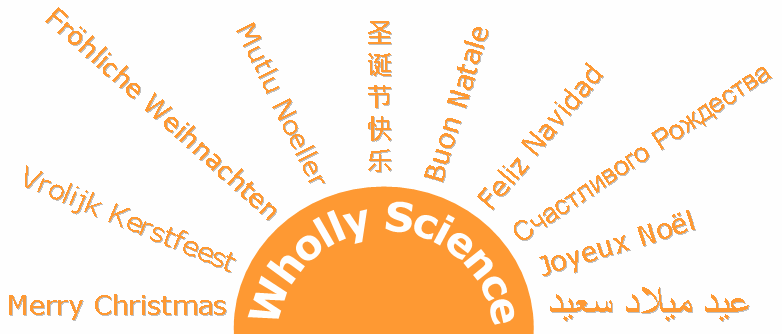


 |
 |
 |

|
 |
Let us start with the adjective, so as to preserve the difficult part about the noun for last. In English, we say “Merry”, which has the same meaning as the French “Joyeux” and the German “Fröhlich”. Slightly different, the Spanish “Feliz” means “Happy”, and so does the Dutch “Gelukkig”, while the Italian “Buon” simply means “Good”. So the annual celebration of December 25th is joyful, happy, or good in these languages.
In the naming of this celebration, there seams to be more variety. However, these names in the Roman languages all turn out to be variations that originated from the Latin words “Dies Natalis”, meaning “Day of Birth”. Thus the Italian “Natale”, the French “Noël” and the Spanish “Navidad” in fact all mean “Birthday”. This is of course the birthday of the Light Bringer, also known as the Risen Savior, the Sun of God, and the Christ.
Not only the night before this sunrise on December 25th is sacred, but both previous nights as well. That is why the name of this celebration period is called “Weihnachten” in German, meaning “Sacred Nights”. In fact, the three full natural days following the annual moment of the winter solstice all have the longest nights and shortest days of the year. The first sunrise after this most dark period of the year is on December 25th.
The English designation of “Christ” originated via the Latin “Christus” from the Greek “Kristos”, which literally means the “Anointed One”. This title tells us that Jesus is above us, like a Lord. In fact, Jesus is (or can be) our Heavenly Lord, also known as “Our Father who art in Heaven”. In order to honor the birth of this Heavenly Lord, the (Roman Catholic) church held a special service to which the Latin name “Missa” was given. This indication was derived from the final words spoken during that service, namely “ite, missa est”, which translated literally means “go, there is dismissal”. The Latin “Missa” then became “Messa” in French, and “Mass” in English. Somehow, the name of this Mass in honor of the birth of the Christ changed from “Christ Mass” into “Christmas”.
Long before the Roman Catholic church brainwashed the conquered peoples, the Germanic population of the Northeast of Europe were already celebrating this annual rebirth of the Light Bringer. This Midwinter Feast was called “Jul” in the ancient Germanic language. In English, this became “Yule”, and also the name “Yuletide” is still present in the English language. And in Danish, this feast is still called “Jul”.
Our Germanic ancestors knew exactly what they were celebrating. I whish that I could say the very same about contemporary man. Nevertheless, I wish you and your loved ones a very good, joyful, and happy celebration of this year’s Midwinter Feast, one week from today.
Only when you are not sure, you might want to believe something. On the other hand, when you are sure, you have no need of believing in anything. Therefore, believing is a kind of stopgap for people who do not know.
But there is more, as believers no longer have an open mind on all issues related to the belief that they have accepted (without real proof) as being true. This means that believers are no longer capable of listening to anything that is considered a threat to the survival of this belief. Maintaining their belief becomes much more important than discovering the truth. Therefore, believers choose to ignore all counter-information. Being ignorant of the truth therefore results from accepting any belief as a truth replacement.
For many years now, I am helping to enable Christian believers to break free from the myth of an historical Jesus. The writers of the Good Message (commonly translated into English as “Gospel”) Gnostic initiates who used parables to share their insights with anyone who had an ear to hear. The allegory of the wise man who built his house on the rock versus the foolish man who built his house on the sand is all about the essential difference between “knowing” and “believing”.
If you want to know the truth about “Bethlehem”, then you definitely want to see episode 8 of Wholly Scripture TV. In that episode, I proof that the town of Bethlehem did not exist 2000 years ago, next to other historical facts that show once and for all that Jesus as a man was and is a Roman lie to prevent ignorant believers in finding out the Gnostic truth of the Good Message.
The old website of Pateo.nl was created using HTML frames. These frames then divided the computer screen into several parts, after which each part displayed a separate HTML file. A decade ago, I thought this was a clever way of making a website. Now I know that I have underestimated the disadvantages of using frames, like the scaling issues as a consequence of many different screen sizes and proportions nowadays, and the problems with directly linking to webpage without losing the files of the other frames. After trying a solution with meta files, which are not working well with the indexing systems of the internet search engines, because these meta files themselves have no real content, I decided to upgrade the Pateo.nl website. I already work with Wordpress for my WhollyScience.org website, but I am not that satisfied with this platform, as I want to preserve the multilingual essence of Pateo.nl. Therefore, instead of using a content management system, I choose to create a new Pateo.nl website from scratch. I thought this would take me about one week, but after having worked full time for two weeks, I’m not even half way yet.
For many people, also the new pateo.nl website is still not flashy enough. However, those who fall for appearances are not in the target audience of Pateo.nl. Anyway, if you want to have a look at the upgraded Pateo.nl website, then click on the above link. Also, the different configuration of these 37th Pateo Newsletter is a consequence of this new design.
Thank you for reading this Pateo Newsletter (and possibly also forwarding it, and/or republishing it).
With Love and Wisdom,
Pateo.NL : Wholly Science (“The wholesome reunification of sound Science and solid Spirituality”)
This is the thirty-seventh English newsletter of Pateo.NL. In order to no longer receive this newsletter in your e-mailbox, just send a message to Bulletin @ Pateo.NL (without spaces) with the subject “Unsubscribe Newsletter” (unless this newsletter has been forwarded to you). By sending “Subscribe Newsletter” to the same e-mail address, you do the very opposite.
This Pateo Newsletter is also available in Spanish and in Dutch.
© Pateo.NL : This page was last updated on 2017/01/14.